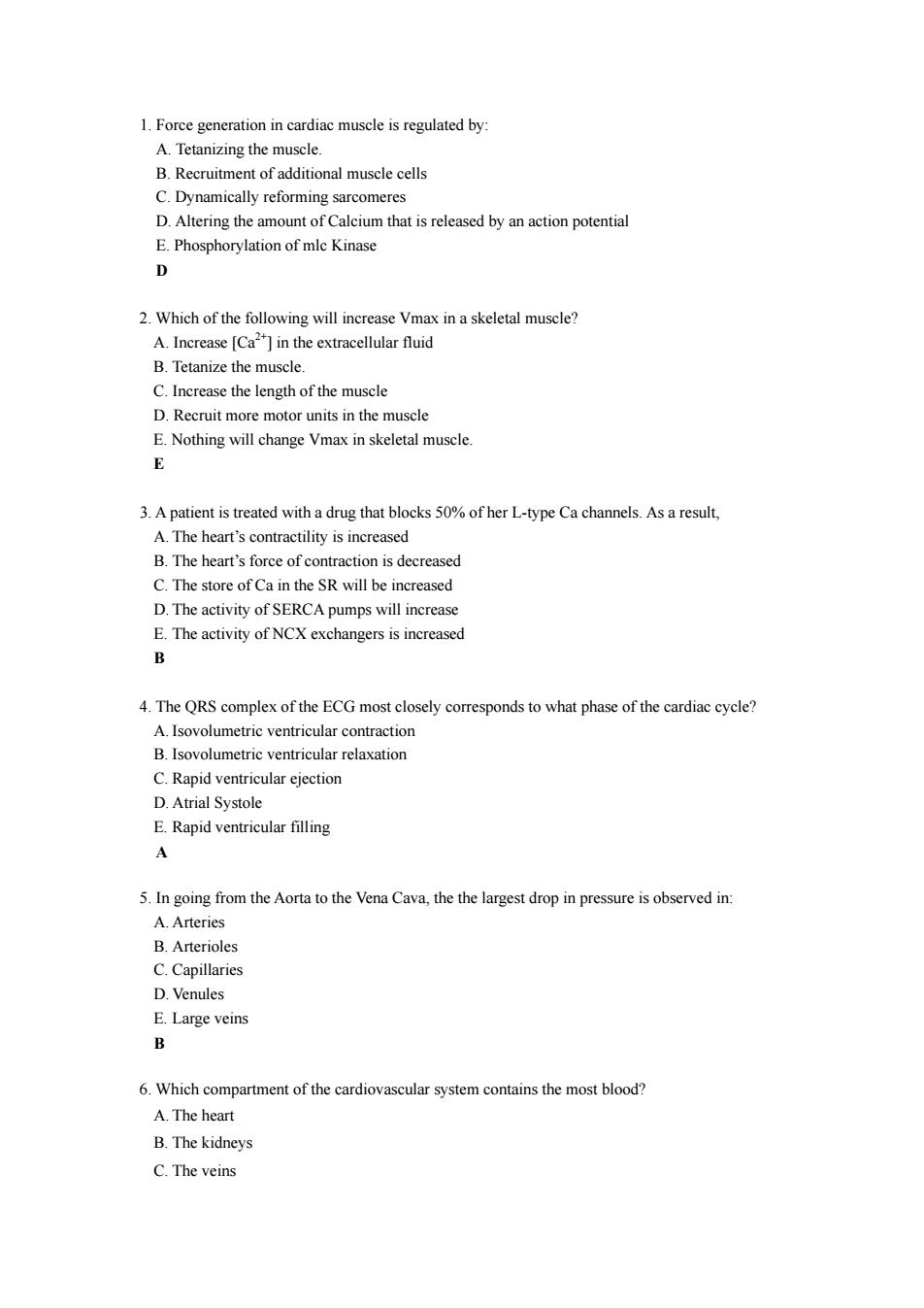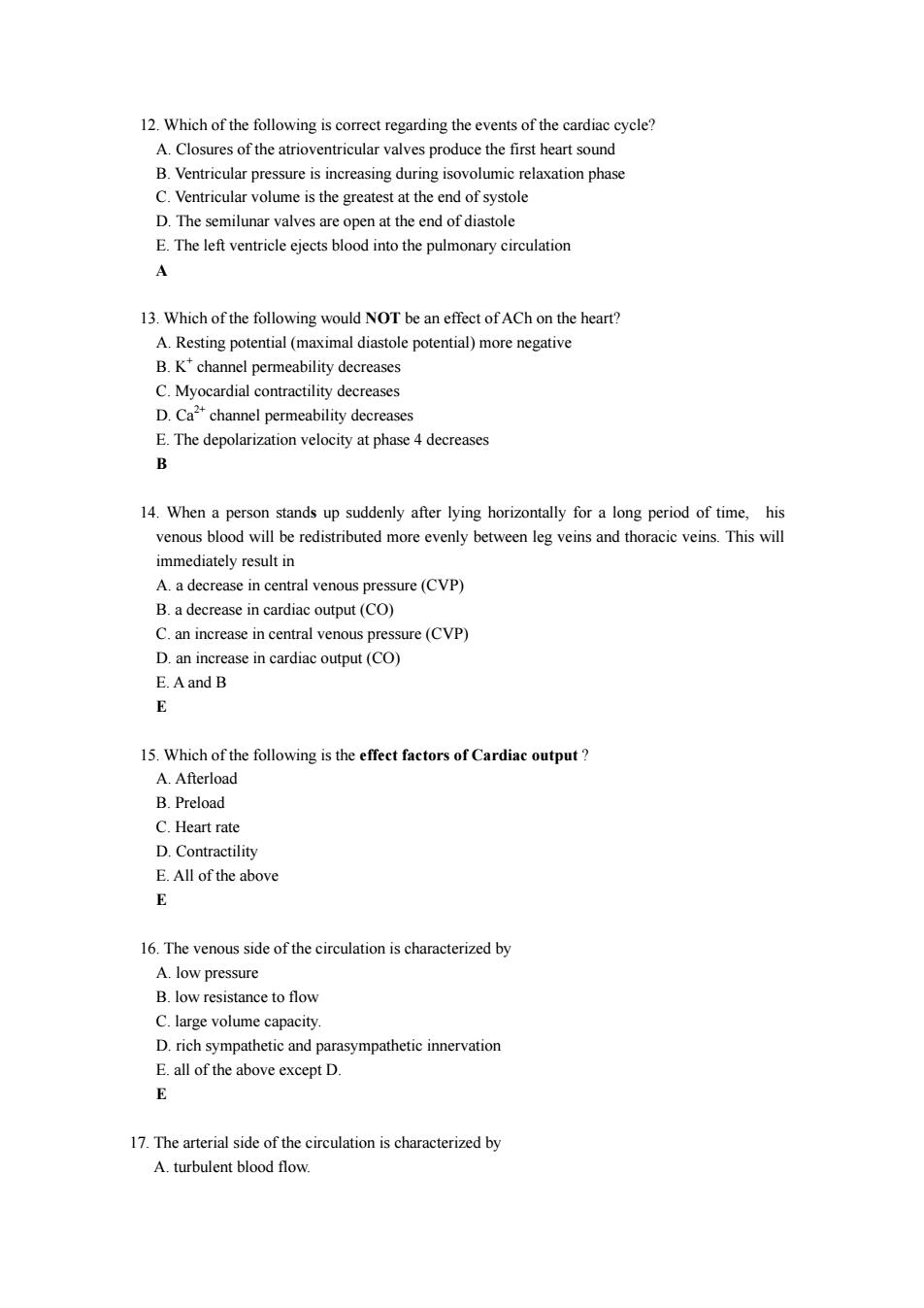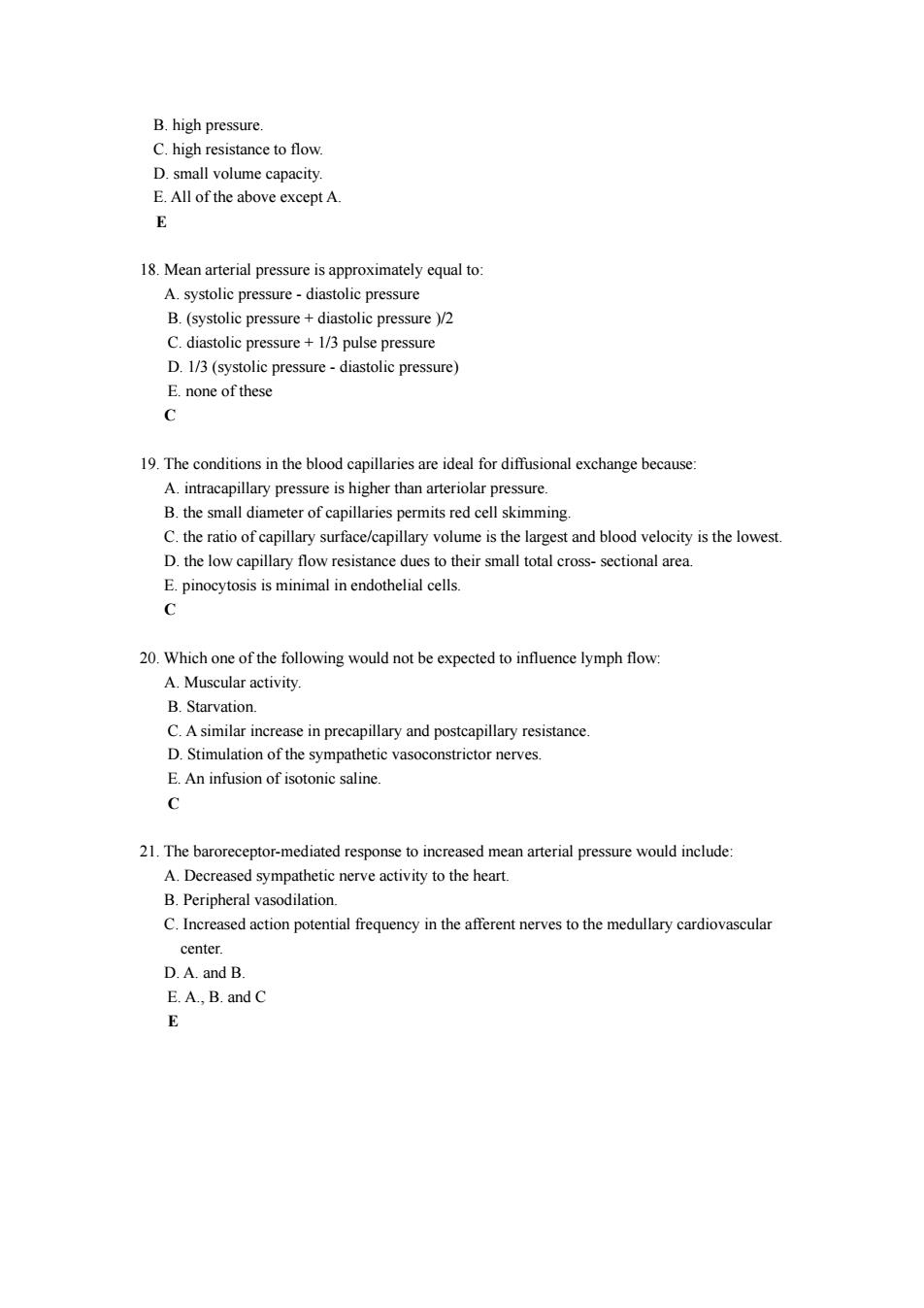
1.Force generation in cardiac muscle is regulated by A.Tetanizing the muscle. B.Recruitment of additional muscle cel C.Dynamically reforming sarcomeres D.Altering the amount of Calcium that is released by an action potential E.Phosphorylation of mlc Kinase D 2.Which of the following will increase Vmax ina skeletal muscle? A.Increase [Ca]in the extracellular fluid B.Tetanize the muscle. C.Increase the length of the muscle D.Recruit morer muscle E.Nothing will change Vmax in skeletal muscle 3.A patient is treated with a drug that blocks 50%of her L-type Ca channels.As a result, A.The heart's contractility is increased B.The heart's fo rce C.The store of Ca in the SR will be increased D.The activity of SERCA pumps will increase E.The activity of NCX exchangers is increased B 4.The QRS complex of the ECG most closely corresponds to what phase of the cardiac cycle? A.Isovolumetric ventricular contraction B.Isovolumetric ventricular relaxation C.Rapid ventricular ejection D.Atrial Systole A 5.In going from the Aorta to the Vena Cava,the the largest drop in pressure is observed in: A.Arteries B.Arterioles D.Venules E.Large veins B 6.Which compartment of the cardiovascular system contains the most blood? A.The heart B.The kidneys C.The veins
1. Force generation in cardiac muscle is regulated by: A. Tetanizing the muscle. B. Recruitment of additional muscle cells C. Dynamically reforming sarcomeres D. Altering the amount of Calcium that is released by an action potential E. Phosphorylation of mlc Kinase D 2. Which of the following will increase Vmax in a skeletal muscle? A. Increase [Ca2+] in the extracellular fluid B. Tetanize the muscle. C. Increase the length of the muscle D. Recruit more motor units in the muscle E. Nothing will change Vmax in skeletal muscle. E 3. A patient is treated with a drug that blocks 50% of her L-type Ca channels. As a result, A. The heart’s contractility is increased B. The heart’s force of contraction is decreased C. The store of Ca in the SR will be increased D. The activity of SERCA pumps will increase E. The activity of NCX exchangers is increased B 4. The QRS complex of the ECG most closely corresponds to what phase of the cardiac cycle? A. Isovolumetric ventricular contraction B. Isovolumetric ventricular relaxation C. Rapid ventricular ejection D. Atrial Systole E. Rapid ventricular filling A 5. In going from the Aorta to the Vena Cava, the the largest drop in pressure is observed in: A. Arteries B. Arterioles C. Capillaries D. Venules E. Large veins B 6. Which compartment of the cardiovascular system contains the most blood? A. The heart B. The kidneys C. The veins

D.The arteries E.Thecapillaries 7.Which one of the following is not the effect of preload on muscle contraction? A.In a limited range,tension caused by isometric contraction increases with the length B.Atoptimal initial tension is develope C.Tension declines when the length is shorter than optimal initial length D.Tension increases when the length is longer than optimal initial length E.Maximal active tension developed at length 2-2.2 um of sarcomere 8.If the ejection fraction increases,there will be a decrease in A.cardiac output B.end-diastolic volume C heart rate D.pulse pressure E.stroke volum 9.Which of the following agents or changes has a negative inotropic effect on the heart? A.increased heart rate B.sympathetic stimulaion C.norepinephrine (NE) D.acetylcholine(ACh) E.adrenaline D 10.Stroke volume is increased by A.decrease in venous compliance B increase in afterload C.increase in contractility D.increase in heart rat E.decrease in coronary blood now C 11.When a pers moves from a supine position to a standing position,which of the following compensatory A.Decreased heart rate B.Increased contractility C.Decreased total peripherad resistance D.Decreased cardiac output E.Increased phaseofthe action potentia D
D. The arteries E. The capillaries C 7. Which one of the following is not the effect of preload on muscle contraction? A. In a limited range, tension caused by isometric contraction increases with the length. B. At optimal initial length a maximum tension is developed C. Tension declines when the length is shorter than optimal initial length D. Tension increases when the length is longer than optimal initial length E. Maximal active tension developed at length 2~2.2 µm of sarcomere D 8. If the ejection fraction increases, there will be a decrease in A. cardiac output B. end-diastolic volume C. heart rate D. pulse pressure E. stroke volume B 9. Which of the following agents or changes has a negative inotropic effect on the heart? A. increased heart rate B. sympathetic stimulation C. norepinephrine (NE) D. acetylcholine(ACh) E. adrenaline D 10. Stroke volume is increased by A. decrease in venous compliance B. increase in afterload C. increase in contractility D. increase in heart rate E. decrease in coronary blood now C 11. When a person moves from a supine position to a standing position, which of the following compensatory changes occurs? A. Decreased heart rate B. Increased contractility C. Decreased total peripherad resistance D. Decreased cardiac output E. Increased phase O of the action potential D

12.Which of the following is correct regarding the events of the cardiac cvcle? A.Closures of the va heart sound B.Ventricular pressure is increasing during isovolumic xation phas C.Ventricular volume is the greatest at the end of systol D.The semilunar valves are open at the end of diastole E.The left ventricle ejects blood into the pulmonary circulation A 13.Which of the following would NOT be an effect of ACh on the heart? A.Resting potential (maximal diastole potential)more negative B.K'channel permeability decreases C.Myocardial contractility decreases E.The depolarization velocity at B 14.When a person stands up suddenly after lying horizontally for a long period of time,his venous blood will be redistributed more evenly between leg veins and th acie veins.This will immediately result in A.a decrease in central venous pressure(CVP) B.a decrease in cardiac output(CO) C.an increase in central venous pressure (CVP) D.an increase in cardiac output(CO) E.Aand B E 15.Which of the following is the effect factors of Cardiac output? A.Afterload B Preload C.Heart rate D.Contractility E.All of the above E 16.The venous side of the circulation is characterized by A.low pressure B.low resistance to flow C.large volume capacity D.rich sympathetic and parasympathetic innervation E.all of the above except D. E 17.The arterial side of the circulation is characterized by A.turbulent blood flow
12. Which of the following is correct regarding the events of the cardiac cycle? A. Closures of the atrioventricular valves produce the first heart sound B. Ventricular pressure is increasing during isovolumic relaxation phase C. Ventricular volume is the greatest at the end of systole D. The semilunar valves are open at the end of diastole E. The left ventricle ejects blood into the pulmonary circulation A 13. Which of the following would NOT be an effect of ACh on the heart? A. Resting potential (maximal diastole potential) more negative B. K+ channel permeability decreases C. Myocardial contractility decreases D. Ca2+ channel permeability decreases E. The depolarization velocity at phase 4 decreases B 14. When a person stands up suddenly after lying horizontally for a long period of time, his venous blood will be redistributed more evenly between leg veins and thoracic veins. This will immediately result in A. a decrease in central venous pressure (CVP) B. a decrease in cardiac output (CO) C. an increase in central venous pressure (CVP) D. an increase in cardiac output (CO) E. A and B E 15. Which of the following is the effect factors of Cardiac output ? A. Afterload B. Preload C. Heart rate D. Contractility E. All of the above E 16. The venous side of the circulation is characterized by A. low pressure B. low resistance to flow C. large volume capacity. D. rich sympathetic and parasympathetic innervation E. all of the above except D. E 17. The arterial side of the circulation is characterized by A. turbulent blood flow

B.high pressure. C.high resistance to flow me capacity bove except A E 18.Mean arterial pressure is approximately equal to: B.(systolic pressure+diastolic pressure C.diastolic pressure +1/3 pulse pressure D.1/3 (systolic pressure diastolic pressure) E.none of these 19.The conditions in the blood capillaries are ideal for diffusional exchange because A.intracapillary pressure is higher than arteriolar pressure. B.the small diameter of capillaries permits red cell skimming C.the ratio of capillary surface/capillary volume is the largest and blood velocity is the lowest. 20.Which one of the following would not be expected to influence lymph flow: A.Muscular activity. B.Starvation C.A similar increase in precapillary and postcapillary resistance D.Stimulation of the sympathetic vasoconstrictor nerves. E.An infusion of isotonic saline. 21.The baroreceptor-mediated response toincreased mean arterial pressure would include A.Decreased sympathetic nerve activity to the heart. B.Peripheral vasodilation. C.Increased action potential frequency in the afferent nerves to the medullary cardiovascular E.A.,B.and C E
B. high pressure. C. high resistance to flow. D. small volume capacity. E. All of the above except A. E 18. Mean arterial pressure is approximately equal to: A. systolic pressure - diastolic pressure B. (systolic pressure + diastolic pressure )/2 C. diastolic pressure + 1/3 pulse pressure D. 1/3 (systolic pressure - diastolic pressure) E. none of these C 19. The conditions in the blood capillaries are ideal for diffusional exchange because: A. intracapillary pressure is higher than arteriolar pressure. B. the small diameter of capillaries permits red cell skimming. C. the ratio of capillary surface/capillary volume is the largest and blood velocity is the lowest. D. the low capillary flow resistance dues to their small total cross- sectional area. E. pinocytosis is minimal in endothelial cells. C 20. Which one of the following would not be expected to influence lymph flow: A. Muscular activity. B. Starvation. C. A similar increase in precapillary and postcapillary resistance. D. Stimulation of the sympathetic vasoconstrictor nerves. E. An infusion of isotonic saline. C 21. The baroreceptor-mediated response to increased mean arterial pressure would include: A. Decreased sympathetic nerve activity to the heart. B. Peripheral vasodilation. C. Increased action potential frequency in the afferent nerves to the medullary cardiovascular center. D. A. and B. E. A., B. and C E